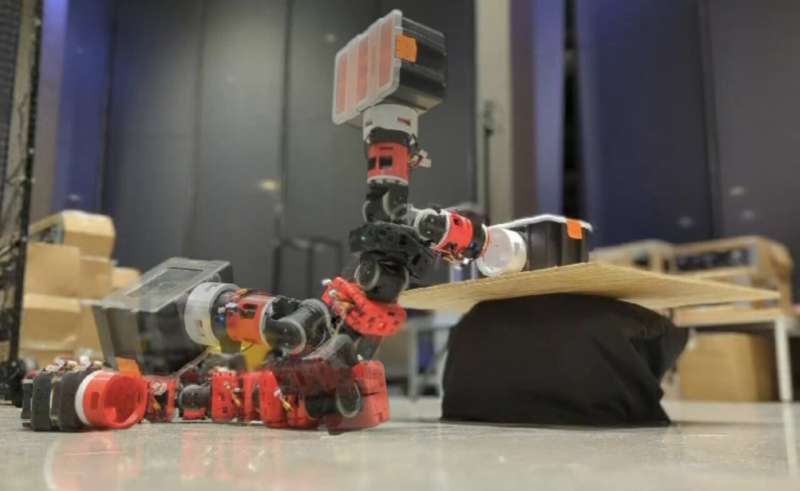May 26, 2024 feature
This article has been reviewed according to Science X's editorial process and policies. Editors have highlighted the following attributes while ensuring the content's credibility:
fact-checked
preprint
trusted source
proofread
An approach to enable both locomotion and manipulation in a snake-inspired robot

Snake-inspired robots could have various advantages over conventional wheeled or legged robots. For instance, slithering robots can adapt the shape of their body, enter narrow spaces, and move freely in environments that are inaccessible to both humans and other robots.
In contrast with many wheeled and legged robots, however, most snake-like robots cannot pick up and manipulate objects. This significantly limits their real-world applications, as it prevents them from completing tasks that entail more advanced interactions with their surroundings.
A research team at Northeastern University's Silicon Synapse Lab supervised by Prof. Alireza Ramezani recently introduced a new approach that could allow snake-like robots to move and manipulate objects simultaneously. This approach, introduced in a paper pre-published on arXiv, was initially implemented on COBRA, a robotic platform developed by a group of students at Northeastern as part of the BIG Idea Competitions.
"We've been developing the snake robot COBRA for almost three years," Adarsh Salagame, Ph.D. student at Northeastern University, told Tech Xplore. "This project started out as a means of exploring alternative locomotion capabilities.
"Differently from standard wheeled or legged robots, snake robots typically exhibit versatile locomotion capabilities, as they can really morph into different shapes and one can control what parts of the body are in contact with the ground. This entails the more precise regulation of contact forces compared to wheeled or legged robots, which only have specific body parts touching the ground."
By successfully allowing the COBRA robot to morph into different shapes, Salagame and his colleagues were able to broaden its locomotion skills, demonstrating five different types of locomotion styles. Subsequently, they also started exploring the possibility of enhancing the robot's object manipulation skills.
"To make the COBRA robot even more functional and versatile, expanding its applications to areas beyond those tackled by traditional robots, we came upon this idea of object loco-manipulation, which entails locomotion and manipulation together," Salagame said. "That's what we achieved with COBRA."
The COBRA robot has a gripper mechanism integrated in its head, which is designed to assist the robot during a specific locomotion mode, known as tumbling. While the robot is tumbling, its head and tail latch together to form a wheel-like structure, thus allowing it to passively roll down a slope at high speeds.
"We repurposed the robot's gripper to latch into a box instead and to pick it up and move it to a different location," Salagame said. "This gives us the ability to both dexterously manipulate a box and move around in confined spaces, slopes or areas where standard robots would not be able to operate."
To realize their proposed loco-manipulation approach, Salagame and his colleagues developed an optimization-based planner that considers ground reaction forces to plan both the robot's movements and object manipulation strategies. In their recent paper, the researchers tested this planner and demonstrated its feasibility.
"We first tested this approach by studying open-loop behavior on the real robot," Salagame said. "The next step will be to implement this closed-loop in simulation and then eventually on the real robot. But what this study showed us is that our approach is feasible. The task we are tackling is not trivial, as when you have such a large number of contacts with the ground, you have a lot of slippage and compliance in the joints, which leads to many errors."
The recent study by this research team demonstrates the feasibility of tackling locomotion and manipulation simultaneously in snake-inspired robots. So far, the researchers have used their approach to study the interaction of the COBRA robot with both the ground and a box. In the future, Salagame and his collaborators plan to further test their approach on more versatile loco-manipulation tasks.
"We are adding a sensor suite on board of COBRA with a camera and an IMU, and we want to tackle more autonomous locomotion tasks using the robot's sidewinding movements," Salagame added. "This is an exciting new aspect that has rarely been observed in robots. Using that morphing capability to change the inertia properties of the robot and change the direction of tumbling.
"We will also use the camera to tackle closed-loop object manipulation, allowing the robot to identify the box, pick it up and move it to different locations, thus potentially tackling interesting tasks that involve high-level planning."
More information: Adarsh Salagame et al, Loco-Manipulation with Nonimpulsive Contact-Implicit Planning in a Slithering Robot, arXiv (2024). DOI: 10.48550/arxiv.2404.08174
© 2024 Science X Network


















